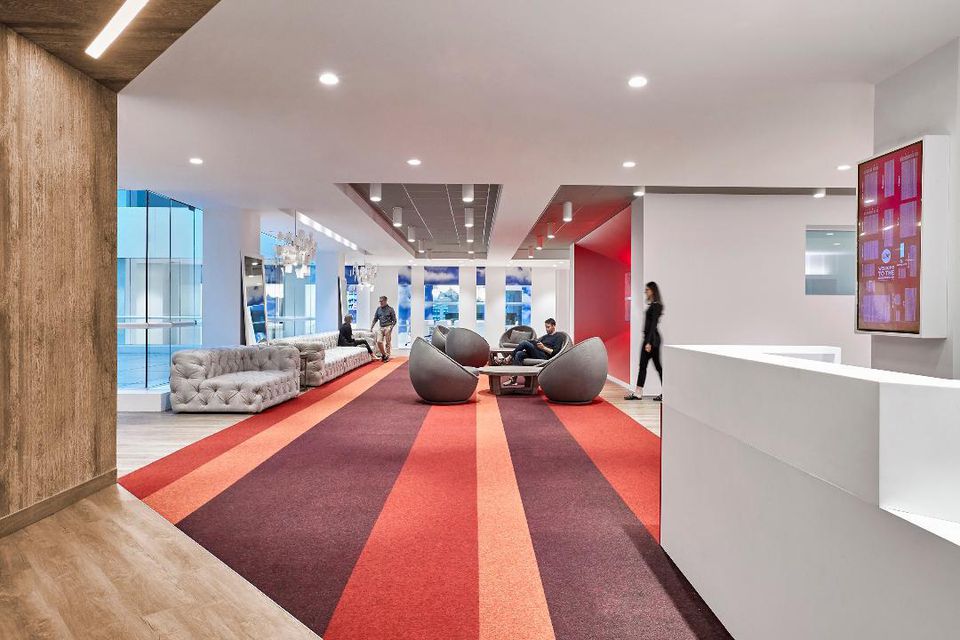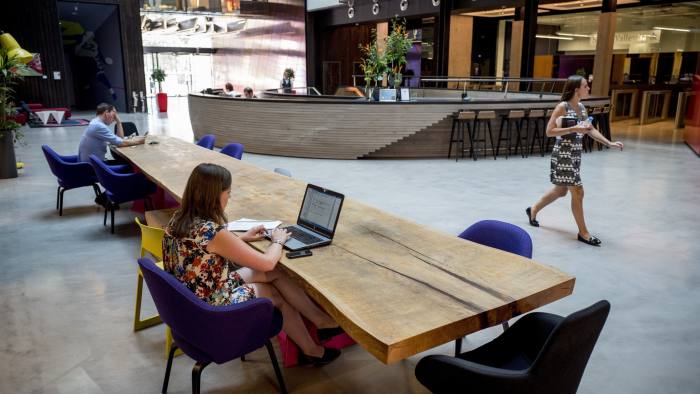Your office reception area is not only the first impression for your business, but it is also the first experience that most people have with your business.
Your guest walks in and they’re instantly greeted by the friendly face of your receptionist. They marvel at the beautiful and fresh interpretation of your company’s brand as the receptionist politely takes their name, invites them to take a (very comfortable) seat, and offers them a nice refreshment. They’re impressed, engaged and intrigued. They can’t wait to see the rest of your office.
You can’t put a price on it, but as the ancient proverb states, “First impressions are the most lasting.” In the grand scheme of things, that makes your reception area extremely important. So when thinking about how to upgrade your reception area consider these five focal points.
1. Start with People & Culture
Companies often overlook culture as an inspiration for office design. That’s a mistake. After all, what could be a better reminder for intangibles like company culture than the way the company’s physical space is put together. Once you’ve summarized it, you can find ways to express the company culture in the colors, furniture choices, wall art, and every other aspect of your reception area.
– Richard KauntzeNow, as the boundaries between work, company culture and private life blur, the reception area is transforming into a ‘social condenser’ — a space that mediates between all three.
Chief Executive of the British Council for Offices
2. Blur the Lines
Reception areas have become less transactional and more experiential. Receptionists are no longer gatekeepers and the reception area is no longer a holden pen for guests. Today, the receptionist is an ambassador and the reception area has become a place to relax, socialize.
For example, a company might have a particularly fancy conference room or a swanky employee break room within eyeshot of the reception area. Hospitality design firm TruexCullins compares this shift to the same shift that hotels have undergone whereby the restaurant and hotel lobby are more integrated. (source)
3. Make it Modern
Most companies work hard to be seen as modern—if not positively cutting edge. Smart visitor registration digital check-in services such as Envoy help to show off your company’s technological savvy while automating certain check-in tasks to speed up that process. They also allow your front desk person to focus on delivering coffee, tea, mineral water, and delightful visitor experience.
London investment firm Investec took the human experience even farther. Their reception area features an expensive-looking wood table with a vase of orange flowers at the entrance with receptionists turned greeters who were ready to guide visitors to where they needed to go. The security desk in the lobby handles the check-in process and alerts the visitee of the guest via a message that they get on their watch. (source)
GET STARTED
Whether you opt for a few small tweaks or a complete overhaul, Corovan’s workplace change experts can assist you with updating your reception area into a space that turns office visits into a memorable experience.
Let’s get moving »4. Have the Right Desk and Chairs
As your guest enters the front door, the reception desk is like a giant signpost saying, “You have arrived.” It should reflect the professionalism and prestige of your company. Find a modern, stylish reception desk that reflects the stature of your company and is an apt projection of the brand.
When deciding on seating, consider the average number of visitors at any given time and how comfortable you want to make them. Add a low coffee table or side tables for magazines, brand literature, and beverages. As a side note, green, eco-friendly furniture may even save you some green on your taxes.
You can also consider it as an opportunity to add a touchdown space where employees can get some work done.
5. Use it as a Co-Working Space
The workforce continues to become more fluid. A 2017 study by Intuit found that thirty-four percent of American workers were contingent employees working as freelancers, part-timers, or temps. That number is projected to grow to Forty-three percent by the year 2020.
With a continual flow of new people in and out, many companies have shifted to offering employees many different places in the office to get their work done. They’re no longer tied to a cubicle or desk, but can work in any number of different spots around the office—including the reception area.


